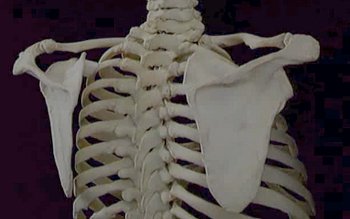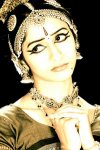
|  |

|  |
 Body Makeup To know what we are made of... - Veena Basavarajaiah, Bangalore e-mail: veenabasavarajaiah@gmail.com March 11, 2011 'Spread your metatarsals on the floor', ' Make sure your patella is in line with your foot', ' Tuck your tail bone in ', ' Be aware of your sternum.' One would normally hear a teacher of ballet or contemporary dance give such instructions in class. A parlance that every student is expected to be acquainted with. A brief knowledge about the constituents of the body is a sign of every teacher's knowledge of strong technique. It is also the teacher's responsibility to create awareness about injury prevention and correct alignment in the students.  The in-depth study of anatomy can take a lifetime, however a movement artist needs to know a few basic things in anatomy like the body being a conglomeration of bones, muscles, cartilages, tendons, ligaments, nerves, veins, arteries and more components. The skeleton is a frame work of bones and is incapable of moving on its own. The bones are connected to each other through tendons and ligaments at joints. The muscles covering and connecting the bones are responsible for moving the body and are strongly reliant on nerves, veins, arteries and more. Every element of the body is seamlessly interwoven and inter-dependent. Why would a dancer need to know about anatomy? Every part of the body is designed to perform a specific function. While the feet, legs and hips are designed to bear weight, support and balance, parts of the body like fingers allow you to perform detailed tasks while many like the rib cage and the skull are designed to protect your vital organs. Similarly, every minute part of your body has a crucial role to play in keeping you alive and letting you move. It is important to know the function, possibilities and limitations of different body parts to understand the mechanics of movement. A simple example. When you do the 'Natyarambha' you have to ensure that your shoulders are not raised. The main components of the shoulder bone are the clavicle (collar bone) and Scapula (shoulder blade) and ensure that these two bones are not lifted creating unwanted tension in the neck region. The dancer also needs to know where and how the muscle 'latismis dorsi' connects the spine, shoulder blade to the arm to be able to engage it efficiently to sustain this basic position in Bharatanatyam. Knowledge of the human anatomy is a must for any artist who works with the body as a medium of expression. A dancer will be able to sense pain and identify its source and prevent injuries immediately. This will also enable the artist to internalize movement, understand the mechanics of the body and develop a strong technique.  Veena Basavarajaiah is a Bangalore based solo dancer and choreographer who is trained in Bharatanatyam, Kalaripayattu, Ballet and Contemporary dance. She has worked with Shobana Jeyasingh Dance Company, Angika Dance Company, Attakkalari, Kalari Academy, Gati Forum, Nritarutya, Natyantharanga & Yana Lewis Dance Co. She has performed on various platforms across India, UK and Europe. She is the recipient of Special Mention Young Achievers Award in 2007 and also a paneled artist of the Indian council for Cultural relations. veenadance.com |